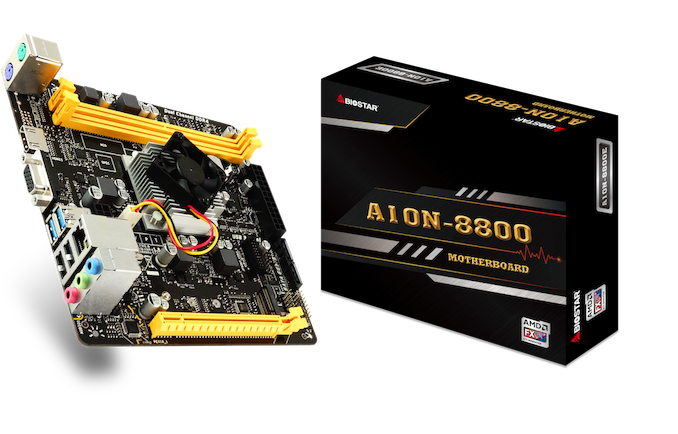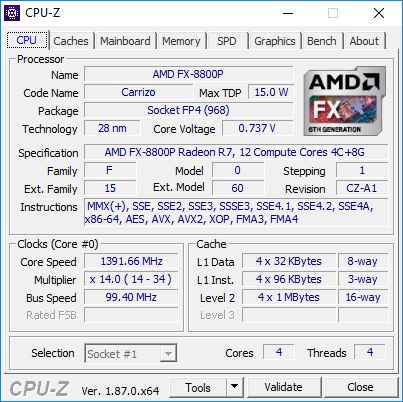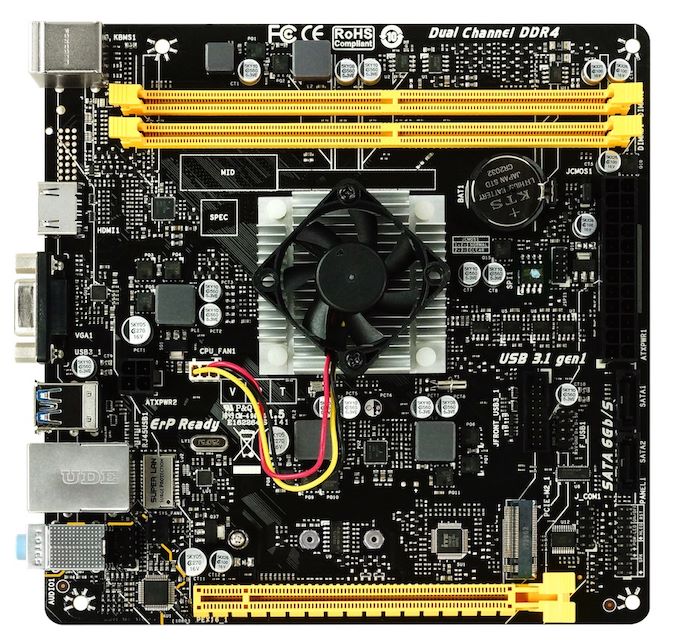The Biostar A10N-8800E Motherboard Review: Carrizo in 2019?!
by Dr. Ian Cutress & Gavin Bonshor on August 14, 2019 8:00 AM EST- Posted in
- Motherboards
- CPUs
- AMD
- Biostar
- Mini ITX
- HTPC
- Carrizo
- A10N-8800E
- FX-8800P
- Athlon 200GE

The Biostar A10N-8800 motherboard is a mini-ITX SoC option with an integrated AMD FX-8800P processor. Also featured is support for up to 32 GB of DDR4-2133 memory, a single full-length PCIe 3.0 x16 slot, and a Realtek RTL8111H Gigabit Ethernet port. The AMD FX-8800P is traditionally a mobile SKU with a TDP of 35 W and Biostar integrates into a small form factor package for desktop users with four CPU cores and eight Radeon R7 graphics cores.
We asked for a review sample of this motherboard for the simple reason that we did not expect to see a brand new AMD Carrizo based design hit the market in 2019. Carrizo is from AMD's older family of processors, pre-Zen, and Biostar believes there is a new market out there for mobile-class gaming machines. The FX-8800E processor being used here sits at the top of Biostar's stack of integrated CPU offerings, which makes it even more bizarre that there are lower powered chips available for this sort of thing. We still wanted to give it our traditional motherboard rundown.
Biostar A10N-8800E Overview
The Biostar A10N-8800E mini-ITX motherboard comes pre-installed with AMD’s FX-8800P Carrizo based SoC processor which utilizes four cores, four threads, with a maximum core clock speed of up to 3.4 GHz. The AMD FX-8800P is the top tier processor from the 6th generation Carrizo family with '12 compute cores' according to the marketing materials: four for the CPU and eight for the Radeon R7 integrated graphics module. With a lot of SoC offerings, low power consumption is a huge factor and the SoC is rated for a 15 W TDP, with OEM configuability up to 35W.
While not benefiting from the kind of grunt power that a processor containing AMD Zen architecture offers, the FX-8800P represents a more modest option and has built-in hardware HEVC and H.265 decoding abilities. That being said, the FX-8800P is using AMD's outdated Excavator architecture, which isn't detrimental as such, but it slots it into a lower positioned tier of products.
Looking at the Biostar A10N-8800E as we do with all motherboards, the board has an all-black PCB with a set of yellow contrasting slots; Biostar could have even gone with the Bumblebee to generate some BUZZ. In the center of the board is the very basic and low profile integrated CPU heatsink, with a basic 2+1 phase power delivery (two for the CPU and one for the iGPU/SoC). Located at the top of the board and mounted horizontally, is two RAM slots with support for DDR4-2133 and up to a maximum capacity of 32 GB. At the bottom is a single full-length PCIe 3.0 x16 slot with a single M.2 slot situated directly above it; a total of two SATA connectors makes up the rest of the onboard storage capabilities.
The rear panel of the Biostar A10N-8800E represents simplicity connectors with just four USB connectors on the rear panel, all Type-A with two USB 3.1 G1 and two USB 2.0. Legacy users will appreciate a separate PS/2 keyboard and mouse port, with an HDMI and D-sub pairing of video outputs. A basic Realtek ALC887 HD audio codec takes care of the onboard audio, while a Realtek RTL8111H Gigabit NIC powers the single Ethernet port.
When it comes to the system performance of the Biostar A10N-8800E, there are certainly some positive points to go away with when benchmarked on our test bed. Booting into Windows 10 64 bit from our Crucial MX300 1 TB test bed SSD, we achieved a very respectable result of 18.6 seconds at default. When stripped of the networking and audio controllers, we managed to shave around an extra second off that time. Power consumption as expected is also favorable with a maximum peak load in our stress testing of just 53.8 W. This was tested without a discrete graphics card as the main focus is on the capability of the integrated AMD FX-8800P processor.
Marketed as an 'Edge Computing' solution, the Biostar A10N-8800E uses a mini-ITX PCB and a mobile processor. With a TDP of just 15 W, it opines to be a low powered desktop system or even a microserver. The motherboard itself has plenty to shout about with a Realtek pairing of networking and onboard solutions which aren't high-end but are more than up to the task, and with integrated Radeon R7 graphics with HDCP support, it could be the perfect foundation for a solid small form factored HTPC.













73 Comments
View All Comments
krumme - Wednesday, August 14, 2019 - link
Wsa vs wsaFight!
Smell This - Monday, August 19, 2019 - link
Wafer Supply Agreements ?I'm thinking AT missed the boat on this one. Show us a 'head-to-head' with the 'old' AMD Carrizo against the Gemini/Apollo 'Mistakes by The' Lakes ...
cen - Wednesday, August 14, 2019 - link
Not sure who this is for?DanNeely - Wednesday, August 14, 2019 - link
Entry level DIY NAS would be one possibility; 4x sata would be much better fit for the use case though.My current NAS is build around a 2015 equivalent of this board 4 sata ports (3 used, 2 for storage one for the OS).
cen - Wednesday, August 14, 2019 - link
CPU is fine for a NAS, everything else is not really suitable. I guess it's cheap tho.MDD1963 - Friday, August 30, 2019 - link
Yes, who needs more than 2 SATA ports anyway! :)Flunk - Wednesday, August 14, 2019 - link
Atom-based alternatives are cheaper and pull less power.emn13 - Thursday, August 15, 2019 - link
raspberry pi 4 is even cheaper, smaller, and around as fast as an atom; around half as fast as this, and it uses *much* less power (7.6W under load!) . It's a considerable step up from from the pi 3; and it comes with usb3, so it's quite decent for a NAS too, and even for reasonable webbrowsing and 4k 60Hz video decoding. Frankly, it's I'm not sure why you've ever bother with an atom or something like this given the price and power difference if you're looking for a media center or NAS. And the whole thing is just 35$! And another advantage is the community; since there's relatively little pi hardware variation in the core bits, you can be sure your linux distro is being used by lots and lots of hardware nerds and likely very well supported for a long, long time. Seriously, it's just no competition.However, if you want to run any x86 games or legacy office apps rather than say, google docs, then the atom or this thing makes more sense. But as a tiny home server / media center? The Pi is better in almost all ways: much cheaper, much less power hungry, much more likely to be long-term better supported, and almost as fast.
LoneWolf15 - Monday, August 26, 2019 - link
A Pi is far more limiting on I/O throughput even with USB3.Don't get me wrong, a Pi4 is great for HTPC use, or other embedded computing, but it just doesn't have what I'd want for storage options for a NAS or microserver.
I'd be much more likely to look at something like this:
https://www.asrock.com/mb/Intel/J5005-ITX/index.as...
I had the Braswell one for a bit; while I'm not normally an Asrock fan, the product was quite reasonable, or would have been if Intel hadn't gimped the video a bit and not publicly disclosed it (fixed in Apollo Lake and Gemini Lake CPUs).
mr_tawan - Thursday, September 12, 2019 - link
I don't have a PI4. Had use PI2 before I moved to a Zyxel NAS (with Arch Linux). I'm looking for replacing the Zyxel with probably my current PC (Core i5 4460).Anyway, during my PI2 day, I found it has some stability issue (it crashes every now and then) and the transfer rate is not that impressed (single digit on SMB if I'm not mistaken).
So how does the PI4 performs in those area then?